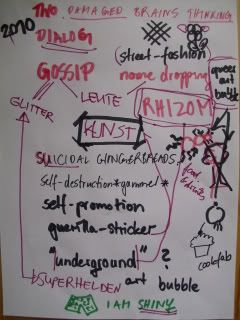
I have been writing manifestos for a belletristic journal then. CINE QUA NON, as it has been characterized by Margarida Vale de Gato in the magazine's latest edition, is a space for ponderings, wonderings beyond the limitations of the norms of academic writing in the Humanities. I wrote a fictional play for paper dolls; it was published in the essay section after all. CQN is providing a playing field for the personal, the ambivalent, the self-reflective; I wandered off into it, forcefully, drunken on its possibilities, the artistic freedom to self-indulge, daring the editors to fence me in, until I could dare them no further. Looking for a cliff to fall off of, I asked “Have I convinced you yet?”, until finally I heard it uttered, “No”; a process of negotiating that is nothing else but what Tiago Patrício describes as the “attempt to understand if [you] are concealing under a mantle of virtue something that does not have a fit of creativity” (CQN #4, 132). I have been writing for CQN from inside out of my head to a forever invisible audience, arguing with them, trying to convince, convert them; when they did not answer, the only way to go was to sharpen my tools, that is to sharpen my words, often times shorten them, organizing them according to the rhythm of a song whose title I did not reveal to them or a visual pattern that only followed the shadows on my desk, tightening the rhetoric. It is the road to the totally idiosyncratic, which strives for the totally transparent; my indulgence was only meant to be enticing, my pretentiousness only meant to be infuriating. To borrow from Julian Hanna's piece on “Avant-garde Manifestos and Guerilla Advertising”, the articles wanted to be “machines to generate discourse” (66), or I should say, less cryptically and more straightforwardly, I wanted them to be just that; or the fuel at least; or the oil. No trace of the distrust in the word here that has left so much of contemporary theatre breathlessly stranded in performance/video art-land, looking around for an audience that is already gone from the balconies, has headed to the gallery or the movie theatre (see Krystian Lada on “Image Dramaturgy”, 32ff.). The word is manifesto, a manifesto for the word.
Even if it's a paper doll, in and out of CQN.
P.S.: I need to apologize to João Botelho in advance who equipped me with the ultimate definition of cinema or life and what's the difference again, it's all “lights and shadows and suffering human beings in between them trying to get out of the darkness and into the light” (116). I gonna use it and abuse it and finally forget it was you who said it in the first place. I am sorry.
P.S.: I need to apologize to João Botelho in advance who equipped me with the ultimate definition of cinema or life and what's the difference again, it's all “lights and shadows and suffering human beings in between them trying to get out of the darkness and into the light” (116). I gonna use it and abuse it and finally forget it was you who said it in the first place. I am sorry.
